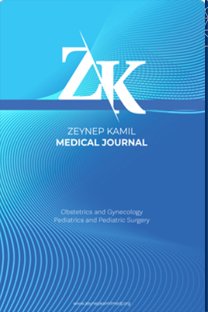The value of measurement of vaginal fluid creatinine and beta-human chorionic gonadotropin in the diagnosis of premature rupture of membranes
The value of measurement of vaginal fluid creatinine and beta-human chorionic gonadotropin in the diagnosis of premature rupture of membranes
___
- 1. Mercer BM. Preterm premature rupture of the membranes. Obstet Gynecol 2003;101(1):178–93.
- 2. Aagaard-Tillery KM, Nuthalapaty FS, Ramsey PS, Ramin KD. Preterm premature rupture of membranes: Perspectives surrounding controversies in management. Am J Perinatol 2005;22(6):287–97.
- 3. Garite TJ. Management of premature rupture of membranes. Clin Perinatol 2001;28(4):837–47.
- 4. Meis PJ, Goldenberg RL, Mercer BM, Iams JD, Moawad AH, Miodovnik M, et al. The preterm prediction study: Risk factors for indicated preterm births. Maternal-fetal medicine units network of the national ınstitute of child health and human development. Am J Obstet Gynecol 1998;178(3):562-7.
- 5. Gibbs RS, Karlan BY, Haney AF, Nygaard I. Erken membran rüptürü. In: Danforth’s Obstetrik ve Jinekoloji. 10th ed. Baskı. Ankara: Güneş Tıp Kitabevleri; 2010. p. 186–976.
- 6. Davidson KM. Detection of premature rupture of the membranes. Clin Obstet Gynecol 1991;34(4):715–22.
- 7. Abbott DS, Radford SK, Seed PT, Tribe RM, Shennan AH. Evaluation of a quantitative fetal fibronectin test for spontaneous preterm birth in symptomatic women. Am J Obstet Gynecol 2013;208(2):122.e1–6.
- 8. Akercan F, Cirpan T, Kazandi M, Terek MC, Mgoyi L, Ozkinay E. The value of the insulin-like growth factor binding protein-1 in the cervical-vaginal secretion detected by immunochromatographic dipstick test in the prediction of delivery in women with clinically unconfirmed preterm premature rupture of membranes. Eur J Obstet Gynecol Reprod Biol 2005;121(2):159–63.
- 9. Lee SE, Park JS, Norwitz ER, Kim KW, Park HS, Jun JK. Measurement of placental alpha-microglobulin-1 in cervicovaginal discharge to diag-nose rupture of membranes. Obstet Gynecol 2007;109(3):634–40.
- 10. Ghasemi M, Jaami R, Alleyassin A, Ansarimoghaddam A. The value of urea, creatinine, prolactin, and beta sub-unit of human chorionic gonadotropin of vaginal fluid in the diagnosis of premature preterm rupture of membranes in pregnancy. Turk J Obstet Gynecol 2016;13(2):62–6.
- 11. Anai T, Tanaka Y, Hirota Y, Miyakawa I. Vaginal fluid hCG levels for detecting premature rupture of membranes. Obstet Gynecol 1997;89(2):261–4.
- 12. Kafali H, Oksüzler C. Vaginal fluid urea and creatinine in diagnosis of premature rupture of membranes. Arch Gynecol Obstet 2007;275(3):157–60.
- 13. Zanjani MS, Haghighi L. Vaginal fluid creatinine for the detection of premature rupture of membranes. J Obestet Gynaecol Res 2011;38(3):505–8.
- 14. Cooper AL, Vermillion ST, Soper DE. Qualitative human chorionicgonadotropin testing of cervicovaginal washings for the detection of preterm premature rupture of membranes. Am J Obstet Gynecol 2004;191(2):593–7.
- 15. Mohamed AM, Mostafa WA. The value of measurement of vaginal fluid urea, creatinine and beta HCG in the diagnosis of premature rupture of membranes. Kasr Al‐Aini J Obstet Gynecol 2011;2(2):41–7.
- 16. Tığlı A, Kurt S, Kopuz A. Erken membran rüptürü tanısında vajinal yıkama sıvısında beta-insan koryonik gonadotropin, kreatinin ve ürenin yeri. Perinatol Derg 2014;22(4):133–7.
- 17. Kuruoğlu YS, Bıldırcın FD, Karlı P, Özdemir AZ. Use of vaginal creatinine levels in detecting premature rupture of membranes Erken memran rüptürü tespitinde vajinal kreatinin seviyelerinin kullanılması. J Surg Med 2019;3(6):421–7.
- 18. Abdelazim IA, Makhlouf HH. Placental alpha microglobulin-1 (AmniSure® test) for detection of premature rupture of fetal membranes. Arch Gynecol Obstet 2012;285(4):985–9.
- 19. Kariman N, Hedayati M, Majd SA. The diagnostic power of cervico-vaginal fluid prolactin in the diagnosis of premature rupture of membranes. Iran Red Crescent Med J 2012;14(9):541–8.
- ISSN: 1300-7971
- Yayın Aralığı: Yılda 4 Sayı
- Yayıncı: Ali Cangül
Validity and reliability of the Turkish version of the Birth Experiences Questionnaire
Fadime BAYRI BİNGÖL, Meltem DEMİRGÖZ BAL, Melike DİŞSİZ, Sümeyye TOKAT, Melek IŞIK
Yeliz DOĞAN MERİH, Dilek COŞKUNER POTUR, Gülten KARAHAN OKUROĞLU
Masum KAYAPINAR, Gökalp ŞENOL, Gökhan ÜNVER, Zafer BÜTÜN, Kamuran SUMAN
Recurrent pericarditis caused by familial Mediterranean fever: A case report
Dudak ve/veya damak yarığı olan bebeklerde beslenme problemlerine yaklaşım
Osman Enver AYDIN, Ayla Gülden PEKCAN, Abdullah Barış AKCAN, Fatih SIRIKEN, Arif Aktuğ ERTEKİN, Ender CEYLAN
Hasan TURAN, Zafer BÜTÜN, Ebru ÇÖĞENDEZ, Sinan ERDOĞAN, Erdal KAYA
Five years outcomes of hysteroscopy experience in a tertiary center
Burak SEZGİN, Ercan SARUHAN, Eren AKBABA, Melike NUR AKIN
Handan HAKYEMEZ TOPTAN, Sabiha PAKTUNA KESKİN
Prenatal diagnosis and management of hypoplastic left heart syndrome: Single center results
Gürcan TÜRKYILMAZ, Yunus Emre PURUT
Report of a pregnant woman with mosaic Turner syndrome
Yunus Emre TOPDAĞI, Ali İrfan GÜZEL, Emsal Pınar TOPDAĞI YILMAZ, Seray KAYA TOPDAĞ
